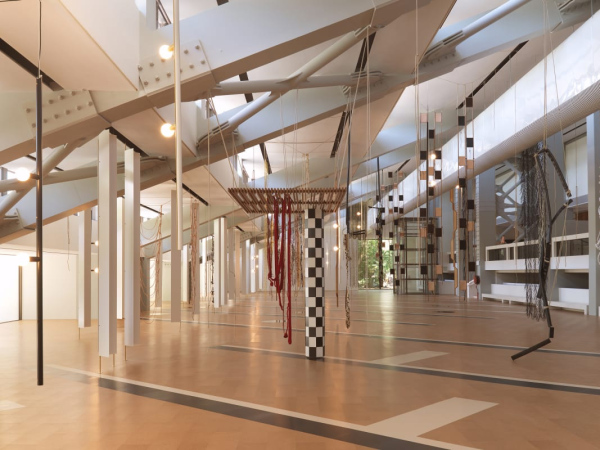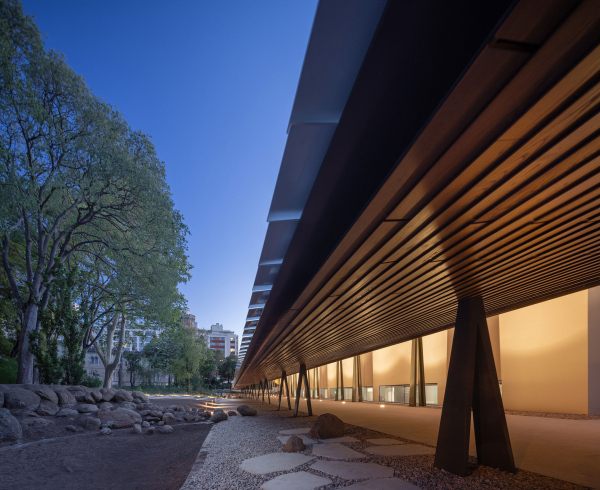

Exterior view of Kengo Kuma’s extension to the Centro de Arte Moderna Gulbenkian
Published: Art Monthly, December 2024
Letter from Lisbon: Old and New
I left my flat for Lisbon early in the morning, before the sun was up. I stopped and looked out from the tenth floor, a heavy fog had settled over the whole of the Loughborough Estate: the tower blocks were floating in clouds, yellow streetlights blanketing the view with a warm glow. It would be hours before its slumbering inhabitants awoke but I was already beginning to write – what did it portend?
Serenely tired, my ears feeling as if full of cotton wool, hours later I arrived at the newly renovated Centro de Arte Moderna Gulbenkian (CAM). Following the garden path gently sloping down to the building, I come to the elegant new entrance way, a curved roofed walkway designed by Kengo Kuma, the enormous 100m-long structure supported by delicate, recessed V-shaped columns. Cast under shadow they are almost invisible, making it appear as if the roof is levitating. Covered in white tiles, reflecting Lisbonʼs changing autumn sun, the design was inspired by a type of architectural structure called an engawa, a sheltered walkway common in traditional Japanese housing. CAMʼs director Benjamin Weil tells me that the new extension is considered neither pubic nor private, a transitional space between the museum and the city, intended to be a link between the old and the new, screening the original building while simultaneously revealing it.
Before I left, I discovered that the old part of CAM, completed in 1983, was designed by Leslie Martin, the same architect who, 30 years earlier, built the nine slab blocks of Loughborough Estate in south London where I live. The museum somehow felt like part the mental map I have of my local area. How to interpret these connections? I was struggling to create a singular picture of the place. Do I impose order or let myself be led by chance encounters and unconscious impulses? In his 1936 essay‘Narrate or Describe’, a critique of formalist fiction, the Marxist literary critic and theorist Georg Lukács writes that ‘description contemporises everything’, every aspect of experience is treated with equal importance, ‘smothered under a blanket of delicately delineated minutiae’, whereas the narrative novel moves between past and present ‘with the greatest deftness’, allowing the reader to grasp the ‘real causality of epic events’, only including the important details. Lukács seemed to relay the impossible challenge of trying to sum up a whole cityʼs art scene. I felt I had to see as many shows as I could, but if I wanted to tell any kind of story, I couldnʼt include everything. I would have to search for the links.
CAMʼs first exhibition in the new space is Leonor Antunesʼs the constant inequality of leonorʼs days, which takes its title from a 1972 Ana Hatherly drawing, made the same year of Antunesʼs birth; two years before the democratic revolution brought to an end Portugalʼs 48-year dictatorship (1933–74). This was a period when the country was isolated politically, culturally. The artistʼs work extends outwards, across both time and space, from Lisbon, the city of her birth. Through ‘acts of transmission-incorporation-transformation’, as Rita Fabiana writes in her catalogue essay, Antunesʼs work creates new connections to artists, designers and architects, mainly women who have been forgotten, erased or excluded from across the international modernism movement.
The exhibition is organised into two parts. On the mezzanine level, the works of around 30 women artists selected by Antunes, mostly Portuguese, most from the CAM collection. In the main space, a series of the artistʼs hanging sculptures that almost touch the ground, just before the point of contact, a moment full of potential. There are long stretches of framed rattan, some languid and curved, some geometric, solid. In the same space, delicately linked brass strands barely hold together, like fragile jewellery. There are lengths of knotted leather, some as long as eight metres, tumbling down from the ceiling. These works are inspired by the design of bridles, as well as preparatory studies made by Italian architect Carlo Mollino for the Turin Horse Riding Club. Antunes is drawn to these forgotten histories, the bridle a symbol of bodily control that could be linked to patriarchal repression, tangles of coiled energy, ready to rip free.
Sadie, 2024, is a dedication to the wife of Leslie Martin, the architect and designer Sadie Speight, who collaborated with her husband on a number of the projects, though never received the same recognition: ‘Forgotten as soon as her husband became a Sir,’ Antunes tells me as we walk around herexhibition. This looping hanging is made of red and white glass beads, using the same square pattern from the acoustic tapestries Speight created for Londonʼs Royal Festival Hall, Martinʼs ʻmasterworkʼ say all the obituaries, her accomplishments subsumed by his, written out. As I sit here in my flat tapping away back home, I wonder how of the Loughborough Estate was hers?
Antunes has hung some of the CAM collection works on modular screens that Speight made for the museum in the 1980s. She has also created her own display devices: six panels of slatted kambala wood, from a design by the architect and designer Charlotte Perriand, a recurring inspiration in Antunesʼs practice. Through the gaps in the wood you can see the back of the paintings, the raw undisguised canvas, the collection stickers with their dates and inventory numbers, showing the artifice of artʼs creation, revealing the way institutions construct meaning and value, what they include and exclude.
In CAMʼs inaugural 1983 exhibition, of the 253 artists – exhibiting some 500 works – only 32 were women artists. Covering the whole main gallery, unifying the space, Antunes has created a floor made from cork tiles; a material traditionally used in Portuguese houses, a symbol of womenʼs domestic labour, unwaged and unseen. On the mezzanine floor’s back walls, Antunes insisted the museum leave the chipboard walls unpainted, spatial drawings by the construction team are preserved for the visitors to see: scribbled out calculations, paint splatters, a massive footprint directly above a work of art. The artist said she wants to make visible the hidden labour of construction workers, often migrants. In hercurated selection, Antunes challenges art historyʼs Eurocentricism; for example, Grada Kilombaʼs filmIllusions Vol III, Antigone, is a reinterpretation of ancient Greek mythology drawing on African oral traditions. Antunes told me that she does not seek to create an alternative artistic canon in her work, to either insert marginalised women artists into the existing white male-dominated canon or impose an equally totalising alternative art history. ‘My work is not pedagogic,’ she says. You could say, itdoesnʼt ‘narrate’, at least not in the way Lukács dictates. ‘My exhibitions are acts of celebration,’ says Antunes. Acts of dedication, affinity, convergence, solidarity.
In Émile Zolaʼs and Gustave Flaubertʼs descriptive fiction, says Lukács, social problems are presented as unchanging and unchangeable, personal-familial tragedies occur by chance. By contrast, in the epic narratives of Walter Scott, Honoré de Balzac and Leo Tolstoy, action is determined by the fated laws of historical development, while their charactersʼ struggles exist to reveal the ‘motive forces’ of social injustice. But what if predetermining outcomes, fixing a narrative end point, might limit your capacity to understand structural politics? As Antunesʼs artistic approach might show, maybe it is possible to follow your senses and narrate at the same time, to find in concatenated signs, in tangled affinities, a complex understanding of the causes of injustice, a through-line to meaning.
I try to be led by the few people I know in Lisbon. My friend Alexander Caspari, who I studied art history with at UCL, runs Encounter gallery in Lisbon. His show ‘Passages’ marks ten years since the gallery was founded in London in 2014, relocating to the Portuguese capital in 2022. There are 21 artists in the exhibition, including the João Bragança Gil, the partner of another close friend, Beatriz Medori, a historian of science who was born in Lisbon and who was also at UCL with me. In his series ‘Trouble in Paradise’, 2022–24, João photographs the Portuguese island of Terceira, a popular tourist destination and the site of a US military airbase, in the middle of the North Atlantic, strategically positioned two-thirds the way to Europe and Africa. There are two images on display: one shows the cracking facade of holiday apartments, the sky a blue-grey, high-altitude cloud casting suspicion from above. The second presents gnarled exposed roots, the outer bark ashen, suggesting some violent malignancy, a deep rot taken hold beneath. Joãoʼs gaze is archaeological, dispassionate, but the pictures are highly charged, seething under the surface.
Alexander and Beatriz both recommend Brotéria, a cultural centre, publisher and library run by Portuguese Jesuits that is showing Carlos Nogueiraʼs exhibition ‘densidade e memória’ (density and memory). The venue’s exhibitions engage with politics, philosophy and science as well as religion. The Nogueira show features Paisagem a mandar, 1980, a postcard cased in glass that is displayed at a right angle to the wall. Scrawled in ink on the back: ‘Paisagem a mandar com saudades’. I ask Beatriz to translate. She said the sentence doesnʼt make sense; it would mean ‘Landscape sending with “saudades”’ – a word that only exists in Portuguese, conveying feelings of nostalgia, longing and melancholy. The sensation ran through me: the puffy clouds against a perfect blue sky of the postcard, the sunlight passing through the glass, refracting into a transcendent rainbow of colour.
I finished my trip by accidentally gatecrashing a wedding. I had heard about a 13th-century church, the Igreja de Sao Domingos, which was ravaged by fire in 1959 and never fully restored. All that remained the next day were the walls. A temporary metal roof was installed and remained until 1994, when it was replaced by a new one, but the marks of the tragedy remain: the pillars still black and scarred, the floor slabs cracked, effigies mutilated – the restorers preferred to leave this history visible rather erase it, preserving stories held in architecture, not altogether dissimilar to CAMʼs refurbishment, or to the workersʼ marks left in the exhibition space. When I visit a high society wedding happened to be taking place, the choir begun singing “All You Need is Love”, swaying from side to side in shiny silver robes, the extravagant kitch, still bringing a tear to my eye, overwhelmed by this providential spectacle.